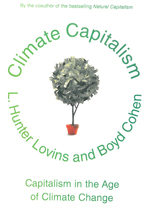Can we clean up the environment and make money at the same time? The answer is yes according to L. Hunter Lovins and Boyd Cohen, the authors of “Climate Capitalism.” They write, “Two words define the current era: ‘climate’ and ‘capitalism.’ ” The authors begin by talking about America’s economic collapse and then reframe the argument around the environment from one of a moral or environmental issue to one of a “crisis of capitalism.”
 The authors write, “What is little recognized is that the twin threats, to the climate and to the economy, are linked in both cause and cure. Unless nations move aggressively to implement energy efficiency and renewable energy, key elements of the transition away from fossil fuels and necessary to save the climate, it is difficult to see how our economy can lift itself from recession or avoid further crises. Solving the climate crisis IS THE WAY OUT of the economic crisis,” (authors’ emphasis).
The authors write, “What is little recognized is that the twin threats, to the climate and to the economy, are linked in both cause and cure. Unless nations move aggressively to implement energy efficiency and renewable energy, key elements of the transition away from fossil fuels and necessary to save the climate, it is difficult to see how our economy can lift itself from recession or avoid further crises. Solving the climate crisis IS THE WAY OUT of the economic crisis,” (authors’ emphasis).
Now that the stage is set, Lovins and Cohen begin providing case studies of sorts of different companies that have improved their bottom line by investing in energy efficiency and sustainable technologies. For example, Toyota became the largest auto maker in the world through the production of hybrid vehicles and fuel efficient cars while U.S. automakers continued to churn out oversized SUVs when a consumer green shift was taking place.
Conventional thinking around the issue of reducing green house gas emissions has held that averting climate catastrophe will cost the world trillions of dollars during a time countries can’t afford to invest due to the financial crisis. However, the authors argue that climate capitalists will seek out economic opportunities in the context of averting runaway climate chaos that will both mitigate climate change as well as offer profits.
Climate capitalists will be successful, the authors write, because they follow the principles of natural capitalism. The first principle is buying time by using all resources as efficiently as possible. The second principle is redesigning how we make and deliver all products and services using approaches such as cradle-to-cradle concepts, Biomimicry, the circular economy, Design for the Environment, and others.
While the information was interesting, and arguably relevant to supporting the authors’ argument, I found it to be a bit difficult to digest – the cause appeared to be information overload. But I still managed to grasp hold of the big takeaway – if you believe that the world is in fact threatened by climate crisis, then can you afford to not do anything? Lovins and Cohen say no. Those who choose not to plan and invest in a future based on sustainable practices will fail miserably.

